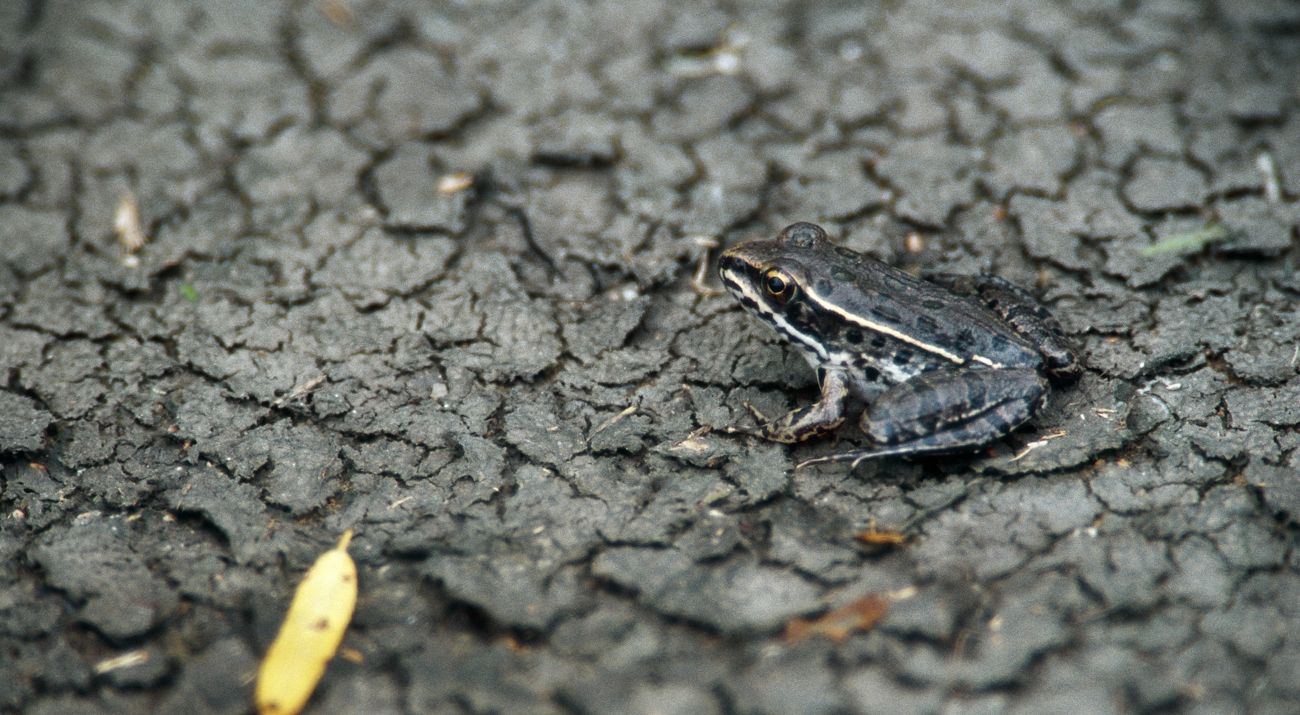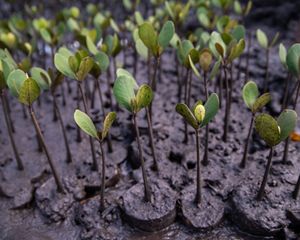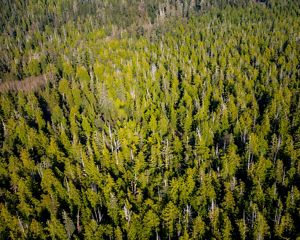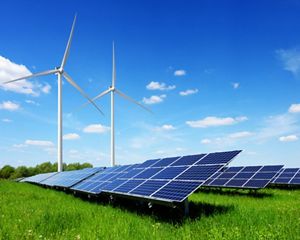Climate Action in Wisconsin
From flooded streets to more ticks in the woods, the impacts of climate change are being felt in Wisconsin—but there's a lot of hope here, too.
Get the latest Nature News from Wisconsin
Sign up for our monthly email to stay in the loop!
Studies show that many of us are concerned about climate change. We’re seeing the impacts of climate change right here in Wisconsin and around the world. Warmer, wetter weather. More flooded streets and basements. Fewer days of ice cover on the lakes and more ticks in the woods. Waterlogged soils that delay planting and harvesting. More harmful algal blooms and less clean water.
No matter what you care about, it’s likely that climate change is already impacting it in some way. At the same time, it seems like such a big problem. Can we really do anything about it?
The good news is that you already are. With your support, The Nature Conservancy (TNC) is working collaboratively with scientists, legislators, business leaders and communities in Wisconsin to reduce greenhouse gas emissions and help natural and human communities adapt to the impacts of climate change.
Protecting Nature Reduces GHG Emissions
One of the most important things we can do to reduce greenhouse gas emissions is protect the forests, wetlands, grasslands and other habitats that capture carbon. Research by TNC and partners shows that these “natural climate solutions” can deliver up to one-third of the emission reductions needed by 2030 to avoid a worst-case scenario.
TNC has been part of the climate change solution in Wisconsin since our inception in 1960, protecting more than 242,000 acres of natural landscapes in places like the Central Sands, Door County, the Kettle Moraine and the Driftless Area. In the Northwoods, we’ve worked with partners to complete some of the largest forest conservation projects in Wisconsin at the Wild Rivers Legacy Forest and the Wabikon and Riley lakes area in Forest County.
We continue to protect Wisconsin’s natural landscapes and are building on that critical work to do even more to reduce greenhouse gas emissions and help people and nature adapt to a changing climate and its impacts.


Take Action with Us
Your generous support will support the best conservation science and climate solutions.
Donate TodayClimate Science Guides TNC’s Work
The science is clear: What we do between now and 2030 will determine whether we will avoid the worst impacts of climate change. One of the questions we're faced with is how to ensure we are protecting the places we know will continue to be resilient and provide habitat for wildlife and plant species as the climate changes.
A new resilience mapping tool, created by TNC scientists in collaboration with partners, is helping ensure that we can invest with confidence in protecting a resilient network of lands and waters across the U.S. We’re using this tool to guide our land protection decisions and sharing it with state agencies, land trusts and other conservation organizations in Wisconsin to assist with their climate-smart planning.
Wetlands play an outsize role in storing carbon and provide other ecosystem services like reducing flood damage and keeping our water clean. To maximize these benefits, TNC and partners in Wisconsin developed a web-based mapping tool called Wetlands By Design to show where wetland protection and restoration can deliver the biggest gains. We’ve made it available to anyone interested in protecting and restoring these amazing habitats.
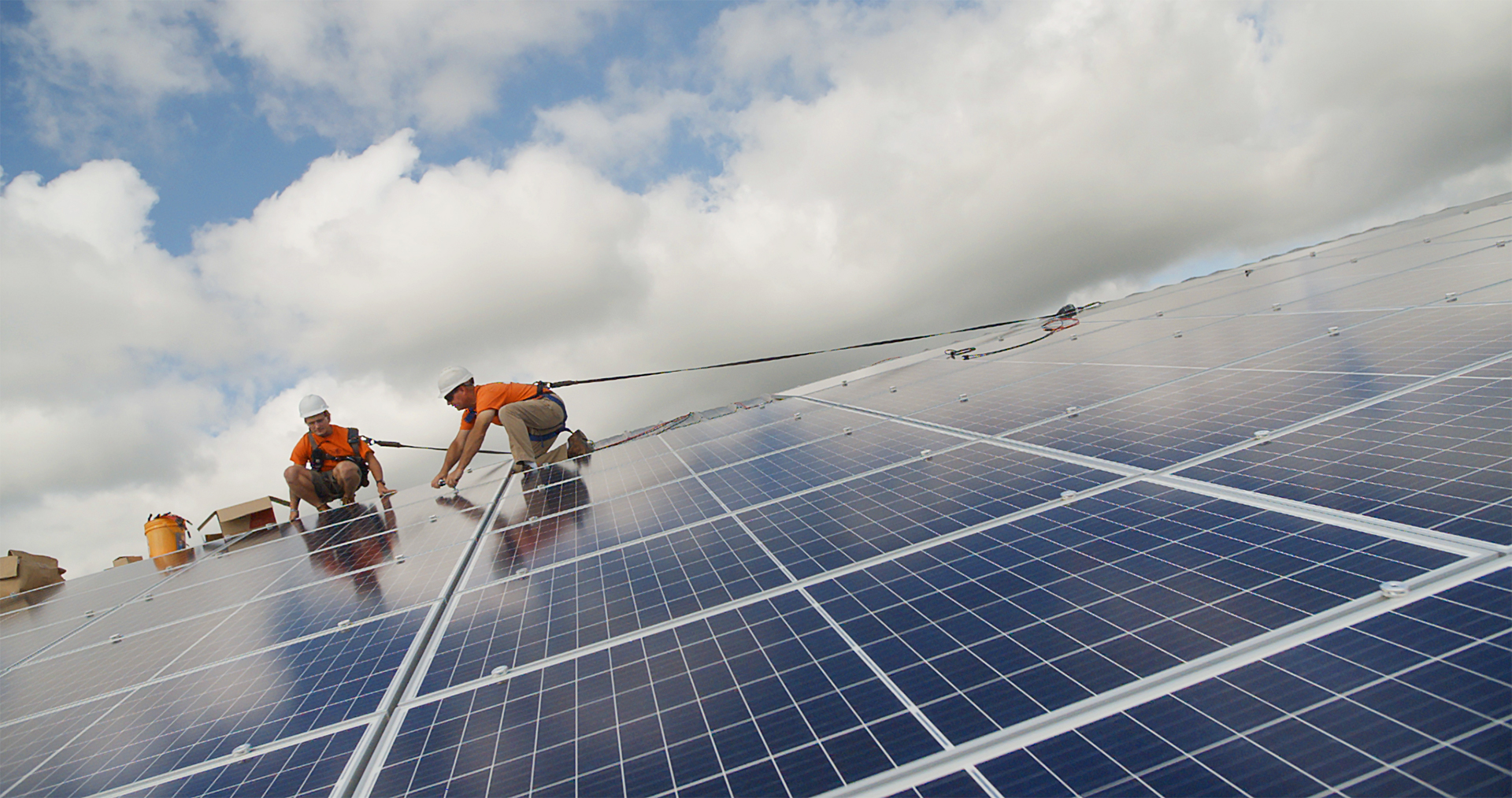
Renewable Energy
Renewables, like wind and solar, will be critical to achieving Wisconsin’s goal of having all electricity consumed in the state be 100% carbon-free by 2050.
Working with Decision Makers to Advance a Clean Energy Future
Clean energy is critical to a strong, thriving economy in Wisconsin and an essential step in reducing the carbon emissions that are fueling climate change. Many decisions about clean energy will be made at the state and local level. In Wisconsin, we connected with iconic companies like American Family and Organic Valley to create the Wisconsin’s Renewable Energy Future report, which outlines the challenges and opportunities they see in transitioning Wisconsin to renewable energy.
We’re using that information, along with our extensive experience with natural climate solutions, to provide the Public Service Commission and policy makers with science-based information they can use to achieve Wisconsin’s goal of carbon-free electricity by 2050.
At the federal level, Wisconsin government relations staff are in regular communication with our Wisconsin congressional delegation on policy and funding legislation needed to advance our clean energy and climate change conservation priorities. We leverage our strengths as a nonpartisan organization and trusted science source to help create consensus on climate issues. Key legislation that Wisconsin has successfully advocated for in recent years includes the Inflation Reduction Act and the bipartisan Infrastructure and Investment Jobs Act.
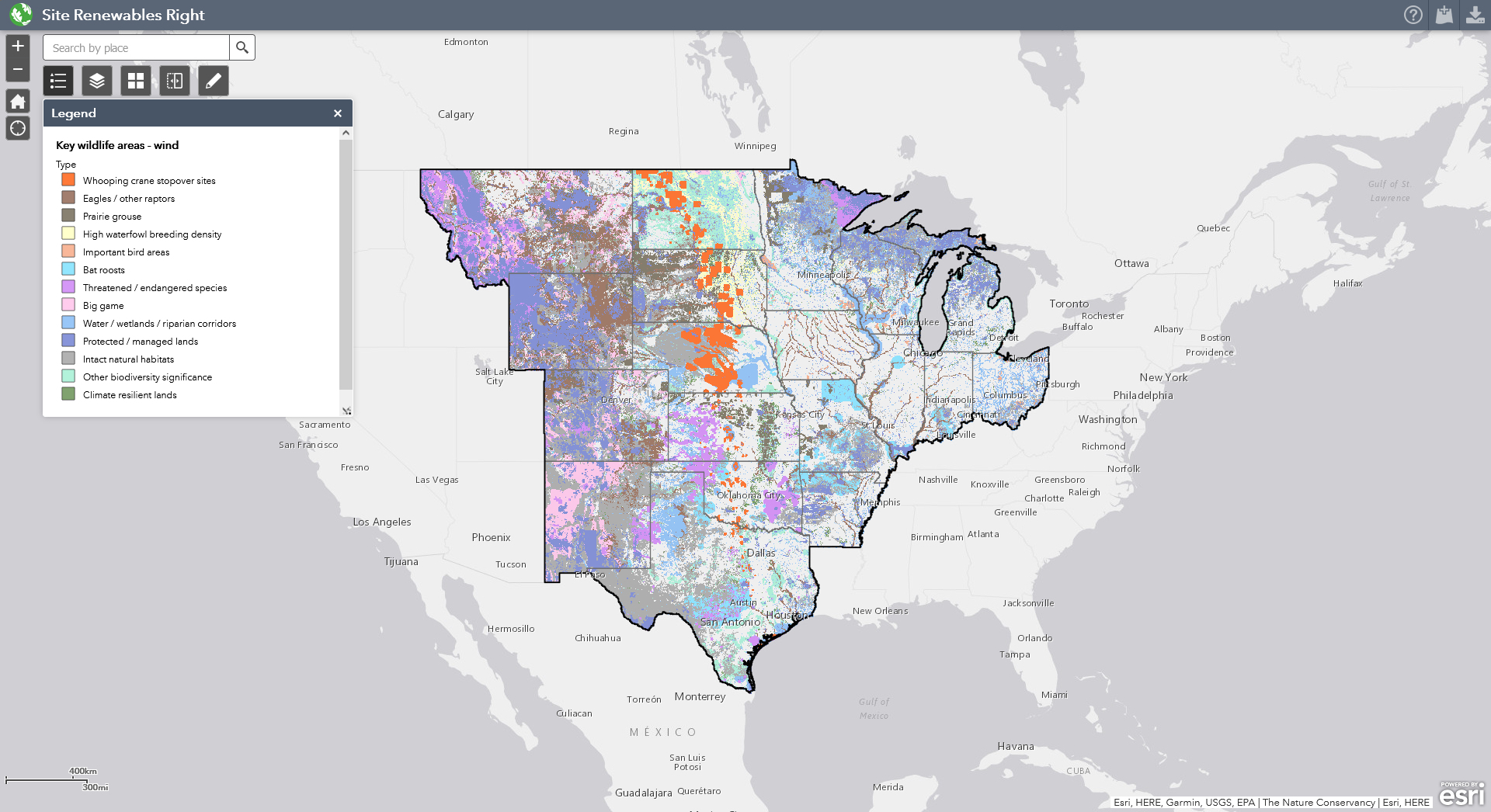
Site Renewables Right
The Nature Conservancy's Site Renewables Right tool has found that there are more than 120,000 square miles in the central United States where renewable energy can be located without disturbing habitats.
Siting is Key to a Better Renewable Energy Buildout
While transitioning to a clean energy future in Wisconsin is critical, it is not without its challenges.
One of those challenges is where to put wind towers and solar arrays, which require a LOT of land. More than 200,000 square miles of land in the U.S.—the size of Colorado and Wyoming combined—could be needed to reach our climate goals.
TNC has developed a free, science-based mapping tool that can help. Our Site Renewables Right tool pulls together the best available science on high-quality wildlife habitat and intact landscapes and is designed to serve as an important source of information for early screening of potential sites.
In Wisconsin, we’re sharing it with renewable energy buyers, developers, planners and others who want to transition to renewable energy AND protect our communities, wildlife and natural areas in the process.
Investing in Climate-Smart Agriculture
It might surprise some to know that milk has a significant footprint on the American landscape, from the land it takes to raise dairy cows and grow their feed to the impacts on water quality and greenhouse gas emissions.
With impact, comes opportunity. The U.S. dairy industry has committed to environmental sustainability, working toward a set of goals that include cleaner water and carbon neutrality by 2050.
Dairy cows are a major source of methane, a greenhouse gas that contributes to climate change. A project that touches down in Wisconsin, called Dairy Feed in Focus, is a collaboration among the Innovation Center for U.S. Dairy and TNC to help reduce methane emissions by incentivizing and implementing best practices in feed and forage production and feed efficiency.
TNC staff in Wisconsin help recruit dairy farmers who sell their milk to Foremost Farms dairy cooperative for the program. We support those farmers’ efforts to adopt soil health, grazing and feed and manure management practices that are expected to deliver climate, soil and water quality benefits on their farms.
Wisconsin Farmers Lead on Conservation
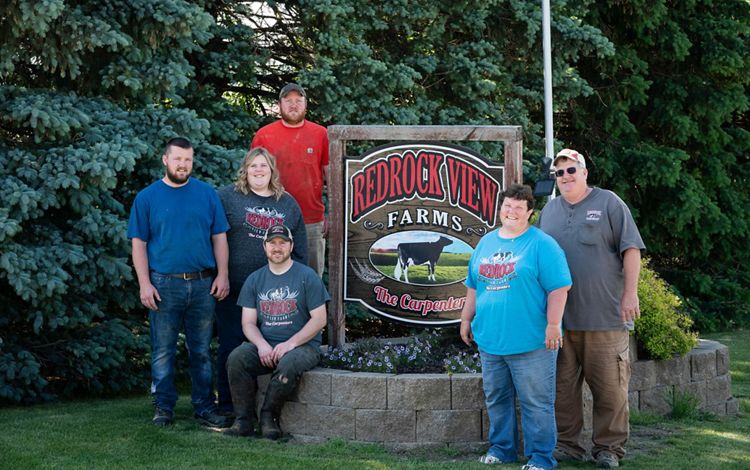
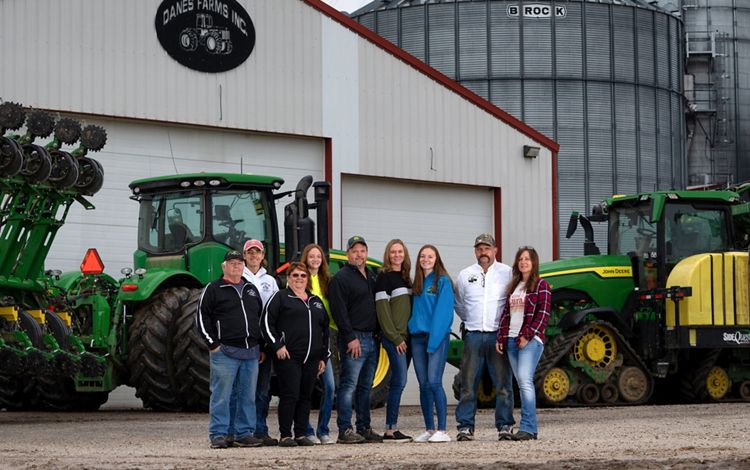
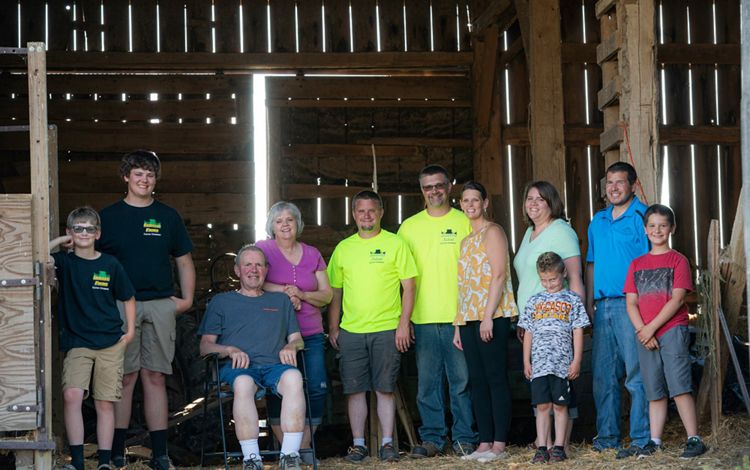
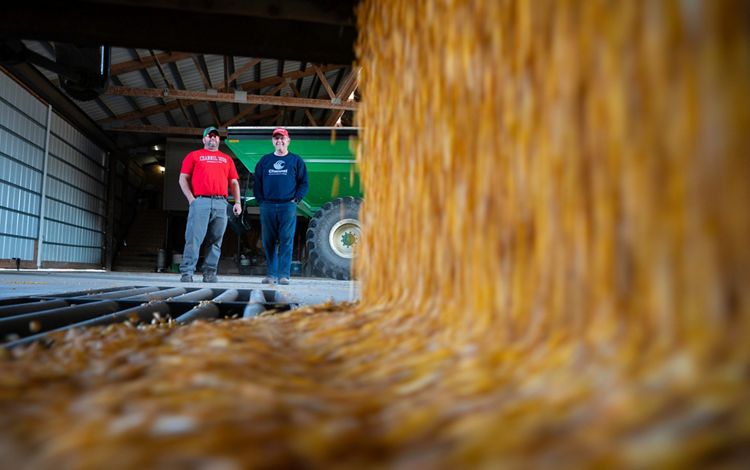
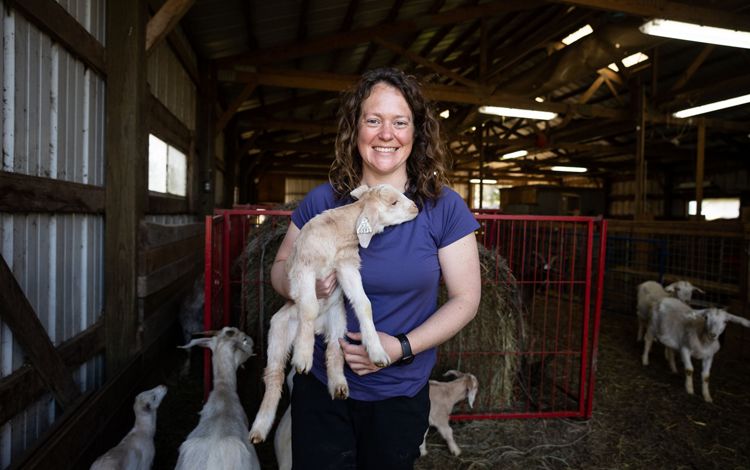
Together with Farmers for Sustainable Food and the Department of Agriculture, Trade and Consumer Protection’s Producer-led Watershed Protection Grant Program, we also support several producer-led watershed groups whose members are planting cover crops, reducing tillage and implementing other soil health practices on their farms. Their efforts will help keep our waterways clean, capture and hold carbon in the soil and make their farms more resilient to climate change.
Family Forest Carbon Program Underway in Northern Wisconsin
Protecting our forests is an important way to reduce the greenhouse gas emissions causing climate change. Trees soak up lots of carbon dioxide. As they grow, they take in carbon from the air and store it in their trunks, branches, leaves and roots, keeping it out of the atmosphere so it’s not contributing to climate change.
Nearly 40% of U.S. forests are owned and managed by families and individuals. But these owners of small forest properties have traditionally been prevented from participating in carbon markets because of the high upfront costs of developing forest carbon projects.
The Family Forest Carbon Program, created by the American Forest Foundation (AFF) and TNC, offers family and individual owners of small forest properties an affordable way to participate in carbon markets, empowering them to help address climate change while earning income from their land.
In September 2022, AFF and TNC launched a Family Forest Carbon pilot project in the Midwest, including in three northern Wisconsin counties. Landowners will receive financial support and guidance on how to improve the diversity of their forests, so they are healthier and store more carbon. We are starting small to ensure that we have the capacity to assist landowners interested in the program—to confirm that their forests meet the eligibility criteria and that their forest management plans are compatible with the program’s goals.


Changing Forest Management to Increase Climate Resilience
Wisconsin’s 17 million acres of forests are feeling the effects of climate change. More extreme storms, drought, diseases and pests are all taking a toll. Economically and culturally important tree species like paper birch are disappearing.
In northern Wisconsin, we are working with partners and using the best available climate science to change the way we manage the forests at our Caroline Lake Preserve to keep them healthy and productive in a warmer, less predictable future. Our goal is to create a more diverse forest in terms of tree species, age and structure, because a more diverse forest will be more resilient to changing conditions, including climate.
We’re helping other forest managers do the same in their woodlands. One of the tools we’ve created, together with the U.S. Forest Service, is a Climate Change Field Guide for Northern Wisconsin Forests that is designed to help foresters consider climate change risks to their forests and develop management actions to help them adapt. We partnered with the Forest Service to develop and provide a counterpart climate change guide for Southern Wisconsin forests.
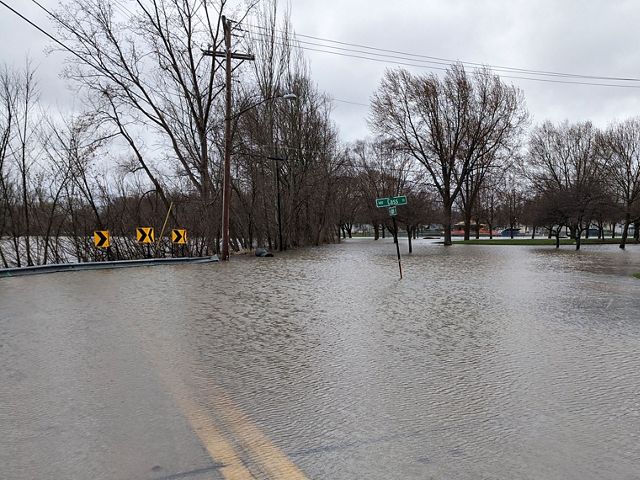
Collaborating on Flood Resilience in the East River Watershed
Wisconsin is getting wetter. “Since 2011, Wisconsin has experienced the wettest decade in recorded history,” according to the Wisconsin Initiative on Climate Change Impacts. And it’s not just snowmelt and more rain, but bigger rainstorms, which our culverts, bridges and stormwater systems are largely not designed to handle.
Cities like Madison, Milwaukee and Green Bay have experienced substantial flooding in recent years and will continue to do so in the future. How can we make our communities more resilient to flooding as our climate changes?
In the East River watershed, which includes the city of Green Bay, TNC is coordinating a collaborative effort to answer that question. The East River Collaborative is connecting municipal leaders, elected officials, communities and citizens across the watershed to implement a variety of interventions and solutions that are designed to mitigate flooding and flood-related impacts.


What You Can Do
Through your support for The Nature Conservancy, you are taking action on climate change. If you’d like to do more, there are other actions you can take to make a difference.
A good place to start is calculating your carbon footprint (the total amount of greenhouse gases generated by your actions). Depending on what you learn and on your personal circumstances, here are some helpful actions you could take:
- Reduce your food-related emissions. Research shows that about one-third of human-caused greenhouse gas emissions globally are related to food. What can you do? Some things to consider are eating more plant-based and locally-sourced foods, reducing the amount of food that goes to waste and composting.
- Rethink transportation. In the U.S., transportation is responsible for more greenhouse gas emissions than any other sector of our economy. What can you do? Some things to consider are reducing the number of long flights you take and choosing direct flights, driving an electric vehicle, carpooling or driving less and using alternative forms of transportation.
- Improve Energy Efficiency. There are lots of things we can do at home to reduce our energy usage and save money. Some things to consider are choosing a high-efficiency furnace when it’s time to replace your old one, shading your home with trees and buying ENERGY STAR-certified appliances.
- Talk About Climate Change. We can’t solve a problem that we can’t talk about. But climate change can be an uncomfortable topic to broach with family and friends. What can you do? TNC’s Chief Scientist Dr. Katharine Hayhoe suggests asking questions, starting with things you can agree on, listening and always being respectful of the other person.
